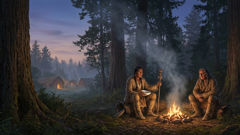Introduction
The Patasola arrives in the story like a whisper carried on a warm wind through tangled leaves: an unsettled note in the chorus of the jungle. Men who come to cut timber, hunters pursuing a wounded peccary, or travelers lost on a narrow path tell the same opening—an apparition at the edge of sight, a reflection of moonlight on skin, a woman standing where no house stands. She can appear as a mourning widow, a stranded beauty, or an alluring mestiza who knows the way home. Her voice is the clever thing—the voice of a lover returning, of a sister calling from the darkness—and the men answer it with the careless courage of those who believe themselves masters of the forest. For a while the tale stays gentle, the image of a woman in a white dress that brushes orchids and ferns. But the Patasola keeps a secret that the jungle itself seems to guard: when the attention of the man shifts from the world to the figure, when moonlight silvers his breath and the path underfoot grows uncertain, she turns. One leg, swollen and unnatural, reveals itself where two should have been. A foot transformed into a cloven root, a limb like a twisted tree trunk, and the song becomes a rasping groan. That moment of revelation divides the world into before and after, and the forest takes on a new grammar—sound becomes a threat, shadow becomes a mouth. In villages from the Magdalena to the Pacific coast the Patasola is invoked as more than a ghost: she is a caution and a shorthand for the wild consequences of greed, infidelity, and disrespect for the living jungle. Men told to avoid her return with an ache called by elders neither pity nor simple fear but a deep recognition that the land keeps its own tally, and that some seductions carry the taste of roots and rot. This retelling gathers the voices of those who have always told her story—the river pilots, camp cooks, elderly women bailing water, and children who smell incense at the edge of town—and tries to listen: not only to the moment the Patasola reveals her single monstrous leg, but to the ways the legend changes when spoken beside a fire, in a church corridor, or beneath the heavy green of the canopy. It is a tale of the jungle as living witness, an old warning shaped by men and women who have made their livelihood in places where the moon is both light and judge.
Origins and First Encounters: How the Jungle Speaks
The tale of the Patasola is both older and younger than any single telling. In the mouths of elders who grew up listening to river songs, she is braided from pre-Columbian belief and later colonial anxieties—the sort of spirit that sits at the intersection of land and memory. Indigenous communities spoke of forest spirits who protected certain groves, who punished hunters for taking without asking or for breaking taboos. With Spanish arrival came new anxieties: sudden deaths, illicit liaisons, and the dislocation of women who found themselves widowed and alone. The Patasola, as the legend crystallized, took these strands and wore them like garments—sometimes a warning, sometimes a personification of grief. Old fishermen will tell you that she is the ghost of a woman betrayed by a lover who became lost in the mangrove; farmers in the uplands claim she is the vengeful spirit of a mother lured into the forest. Every valley folds in its own version, because where the jungle is older than any human claim, stories must adapt.

Imagine a man named Martín in a small Pacific-side hamlet, someone who knows the cadence of storms and the soft cracks of branches that tell of approaching game. One wet season he goes into the forest to track peccary, leaving his wife and small children at the house. Night falls faster than expected under swollen clouds, and Martín pauses on a narrow trail, palms wet with cold sap. He hears singing: a voice clear as a bell, the kind of voice he remembers from a childhood neighbor who made bread and hummed to keep loneliness at bay. The voice says his name. He follows because he is human and because the forest offers its own gravity: footsteps cram themselves into a path where there was none. When he emerges into a small clearing the woman is there, a figure lit by a shaft of moon. She steps forward with the ease of someone who belongs to the world between roots. For a while the scene goes like any reunion: she speaks softly, offers water, asks if he has eaten. Martín, tired by the hunt and comforted by recognition, moves closer without thinking. Then, as the night deepens and the crickets tighten their chorus, the woman's skirt tenses and she swivels. One leg is revealed—long, swollen, bent at a joint that should not exist—and where a foot should be is a gnarl of sinew, knotted like exposed root. It is not the suddenness of horror that freezes Martín but the absurdity: she is both familiar and fundamentally wrong. The voice that called his name grows hoarse. The ground itself seems to murmur. Those who have heard the story say Martín did what many do: he judged the spirit by the rules of men; he reached to touch, to make sense of the contradiction. The Patasola strikes with a speed shaped by the seed of the forest—she is not a creature of metal and measured blows but of the jungle's patience. Some versions narrate a physical attack; others tell of a transformation, a man dragged into the soil and made into a tree on the side of the path, leaves sprouting where a heartbeat once thumped. All versions agree on the lesson: the forest will not be courted by lies, and what appears to be desire may be the land reclaiming an offense.
In some communities the Patasola functions as a storyteller's tool, a way to instill caution. Fathers will mock up her voice, and older sisters will warn younger brothers about wandering to forbidden places after nightfall. But the legend also performs more complicated work. It is invoked during arguments about land, about a man who takes more than he needs, or a lover who betrays trust. The Patasola lives where two moralities intersect: the code of the village and the code of the jungle. She is the manifestation of a social wound—women exploited or abandoned, resources taken without reciprocity—and of a cosmic wound: the forest's refusal to be domesticated. Traditional healers and midwives in remote settlements sometimes speak of knowing when the Patasola is restless: certain orchids droop, bats fly in odd circles, and the river's tone changes. Rituals exist—offerings of tobacco, small crosses, the burning of certain woods—to soothe a spirit who is not entirely malicious but demands recognition. For outsiders, the pattern may look like superstition; for those who have lived close to the green world, it is a language of attention, a set of warnings that keeps people alive and communities intact.
The tale altered with Catholic and mixed spiritual practices. The Patasola would sometimes be prayed against; priests were asked to bless lands, and in some towns the story acquired saints and confessions. Yet even under the weight of prayer, the Patasola kept her edge. Her single leg became a symbol in local iconography and storytelling: a reminder that the land preserves memory. When timber merchants or illegal miners came with rhetorical assurances of progress, villagers pointed to the stories and to the trees—some of which are ringed with marks where men once tried and failed to cut them down. The Patasola's footprints are not always literal; they haunt decisions. A miner who ignores the lore might find his machinery fail, or his crew desert him at dusk. The legend persists because it adapts, folding in new scars of environmental destruction and social betrayal.
Even as the tale warns, it also fascinates. Younger generations, connected by phones and new roads, retell the Patasola through images: murals in town squares, short films shot with trembling cameras, and songs that blend hip-hop with marimba. These contemporary renderings often accentuate her ambiguity—sometimes she is monstrous, sometimes a victim, sometimes a guardian. That shifting identity allows the legend to stay alive. When a woman in the market complains of a husband turned cruel, others will murmur about the Patasola and the justice she metes out. When an outsider laughs at a local superstition, the elders remember names and broken promises, and the laughter is softened by the knowledge that the forest has its own witnesses.
What remains constant is the moment of reveal: the human shape that comforts becomes an index to the nonhuman. The Patasola's single leg is a hinge through which the story swivels from comfort to calamity. As long as the jungle keeps its own reckoning, it seems, the Patasola will not vanish. She inhabits the liminal places—river bends, abandoned plantations, the narrow trails between cacao groves—where memory pools and the boundary between human and environment thins. In some tellings she speaks the names of those who have wronged the land; in others she replaces men who once acted without care. The legend, therefore, is less an isolated myth than an ongoing commentary on relationships: between men and women, between humans and the living forest, and between past harms and present consequences. To listen to the story is to be reminded that the jungle is not a backdrop but an active, moral participant in the lives of those who dwell near it.
Variations, Meanings, and Modern Echoes: Why the Patasola Matters Today
Folklore is a living thing; it mutates, absorbs, and repels. The Patasola has not been immune to transformations brought by migration, media, and shifting social values. Across Colombia's regions the story takes on local inflections: along the Caribbean coast, the woman might be the ghost of a slave's lover, cursed by betrayal; in the Andean foothills she might be a shepherdess punished for abandoning her children; on the Pacific shore she can appear with the smell of river mud and fish scales clinging to her hair. These variations matter because they show how communities use the legend to name specific injustices. The single monstrous leg remains the emblem of the uncanny, but what the Patasola does and why she does it changes according to the moral gravity a given place wants to weigh.

As modernity presses on the jungle—through logging, mining, and roadbuilding—the Patasola has also become an environmental figure. Activists and storytellers sometimes evocate her as a cultural icon of resistance: the forest that fights back. Murals painted in port cities show her with a crown of Heliconia and a machete stuck in the ground like an unhealed wound. In a region where rivers are highways and the forest provides medicine, food, and identity, the Patasola's presence in protest art is logical. She is called upon not simply to frighten men into fidelity but to stand in for ecosystems betrayed by extractive industries. When an illegal road opens and animals vanish, someone says the Patasola's anger has ripened. This blurs the lines between myth and social commentary, but it also deepens the legend's reach: the one-legged woman becomes an eloquent reminder that stories persist because they offer a vocabulary for grief.
Young filmmakers have found in the Patasola a narrative fulcrum that engages global audiences while remaining rooted in local specificity. Short films and documentaries present her with lush cinematography: tight shots of damp skin, long frames of fog moving like a slow tide through the canopy, and the sudden reveal of gnarled anatomy. Social media spreads clips of supposed sightings—grainy footage of a white dress moving among trees—each one receiving skeptical and credulous readings. Tourists sometimes come looking for the Patasola as they would chase ghost stories in other countries, and their presence complicates matters: the very act of searching can disturb places that need protection. Some communities cooperate with responsible tourism programs, using the Patasola story to teach visitors about sustainable practices, while others guard the legend as a guarded, local resource.
Academic voices have entered the conversation as well. Anthropologists analyze how the Patasola functions as a tool of social regulation, how her figure polices behavior and assigns blame. Feminist scholars read the legend as a tale about women's agency in societies where patriarchy and resource extraction intertwine. The Patasola can be a monstrous femme fatale or a woman exacting retributive justice; both readings reveal gendered anxieties and historical imbalances. Environmental historians and ethnobotanists explore the ritual practices surrounding the Patasola—what offerings are made, what plants are included—and find ecological knowledge encoded in ritual. For example, certain plants used in offerings also function as insect repellents or medicines, so the ritual has a practical dimension beyond symbolism.
Personal testimonies continue to fuel the tale's resonance. A midwife in a riverside village tells a story of arriving late at night to help a woman in labor. On her return, she took a short cut through a grove and heard footsteps that matched her own. She looked up and saw a woman with a pale face and a single leg, standing with an expression that was neither cruel nor kind. The midwife hurried away, later learning that a man from her village had gone out with a woman and never returned. In another town an old logger swore that after he felled a certain tree he lost his appetite and his luck with women; he stopped his work and mended fences in town until his grandchildren forgave him. Such stories are often placed in the same register as tales about bad luck or curses, but repeated patterns accumulate into cultural memory. A rumor about someone who vanished near the river will always include the phrase: she had been seen walking with someone who would not be convinced by promises.
The Patasola also teaches about listening. Many narrators stress that the voice is key. Those who survive an encounter often report a pause, a choice, a moment in which they realize they are more afraid of dishonoring their past than of running. The Patasola's call tests the moral imagination: will a man respond because he sees only desire, or will he remember vows, obligations, and the sound of village mothers warning about strangers in the night? In this sense, the legend preserves cultural practices of mutual care. For men, the Patasola story is sometimes reframed as a lesson in contrition: to be mindful of one's steps in the forest is to be mindful of one's steps in life.
Contemporary rituals also reflect an adaptive culture. In certain places young people enact the tale around bonfires during festivals: someone plays the Patasola, half of the crowd acts as villagers, and the rest vote on an outcome. These performances rework the story into communal processing. They keep the tale alive as a vehicle for conversation about trust, land, and lost lives. Digital archives have begun collecting variations, preserving endangered voices that might otherwise be silenced by migration or urbanization. At the same time, cautionary tales assess new dangers: the Patasola is sometimes updated to include schemes of modern cruelty—men taking advantage of women through social media, or corporations seducing communities with empty promises. The pattern endures: the figure of the one-legged woman compels communities to evaluate what they have lost and what they must defend.
Ultimately, the Patasola persists because she embodies a cluster of human fears and obligations rooted in the landscape. She is punishment and protection; she is victim and judge. The single leg is not merely a grotesque detail but a mark of rupture—an entry point into stories about betrayal, ecological harm, and the consequences of ignoring the rules that have kept communities and forests in balance. The legend instructs both respect for the living world and accountability for harm. If you want to hear why the Patasola matters today, listen for the ways her story is called upon when people speak about losing something essential—their father, a forest, trust in a neighbor. The Patasola's foot is the place where consequences find purchase, and the jungle remains, insistent and vigilant.
Conclusion
The Patasola endures because she occupies the complicated border between love and lawlessness, between the human body and the living earth. She is a story told to boys at night, to men who cut trees for a living, to women who guard the village threshold. More than a specter, she is an admonition: when desire blinds you to consequence, when greed severs the ties of reciprocity with the land, some shape will stand up and demand reckoning. Whether conceived as a vengeful spirit, an ecological emblem, or a social corrective, the one-legged woman teaches an ethics of attention—to waterways and woodlands, to vows and children, to the small acts that keep communities healthy. The jungle that birthed her keeps its own ledger; her single monstrous leg is both a wound and a mark of memory. In listening to the Patasola, modern listeners find a voice that refuses erasure: the past lives in the forest, and that memory will sometimes walk among us under the guise of a familiar voice. To respect the tale is to respect where it comes from—the interlaced roots of human culture and natural life—and to remember that not all seductions are without price.













